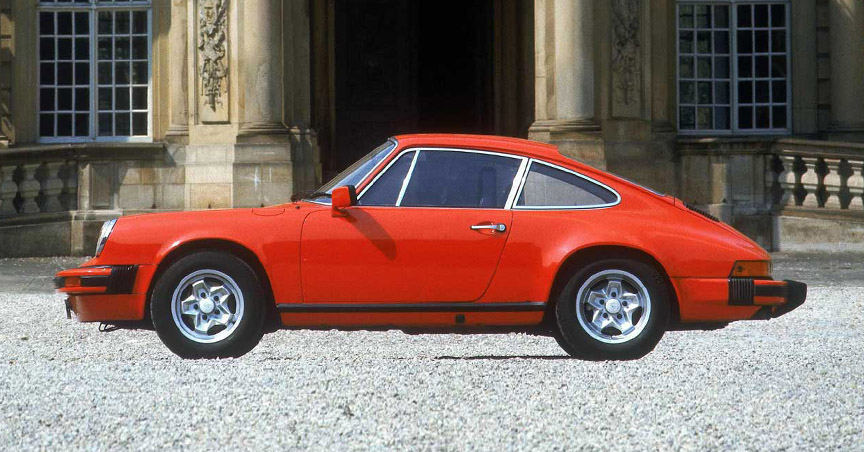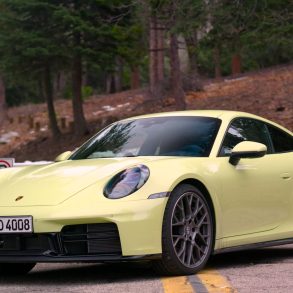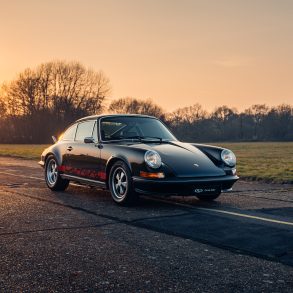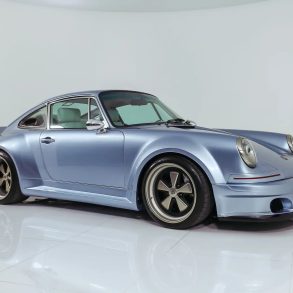Porsche 911 (G-Series) (1973 – 1989) Story & History
G-Model – The 2nd Generation Porsche 911
Premiere: September 12, 1973 IAA Frankfurt
Starting with the model year 1968, Porsche internally assigned a letter to each model year – MY1968 was “A”, MY1969 was “B” and so on. Model year 1974 cars were therefore called the G-models. Although “G” stands for 1974, the cars until MY1989 were all called G-models to distinct them from the first generation 911s, which are sometimes referred to as F-models (“F”=MY1973).
The 911 G-model was presented to the press at the IAA Frankfurt on September 12, 1973 and a day later to the public. The main exterior differences were the impact absorbing bumpers (developed for USA, but used on cars for all markets), the shorter bonnet, the front blinkers that moved from the fenders to the bumper and the rear reflective panel with PORSCHE-lettering that would become a trademark item. The main interior feature were the new seats with integrated headrests. These seats would be fitted for over two decades with minor modifications in all Porsche models except 928.

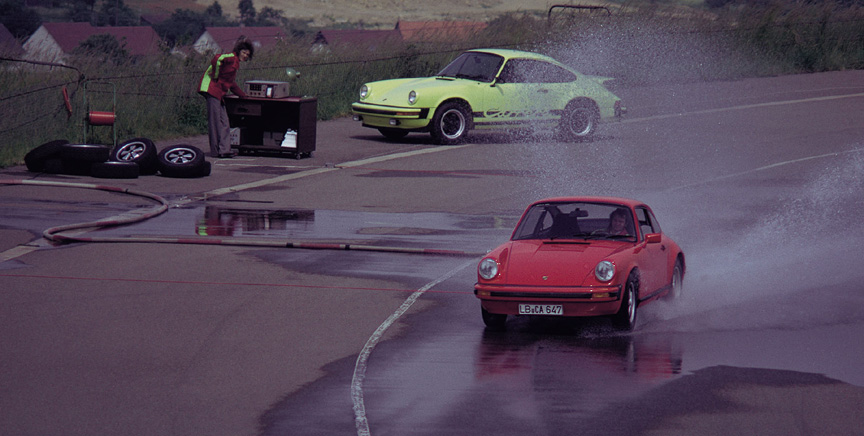
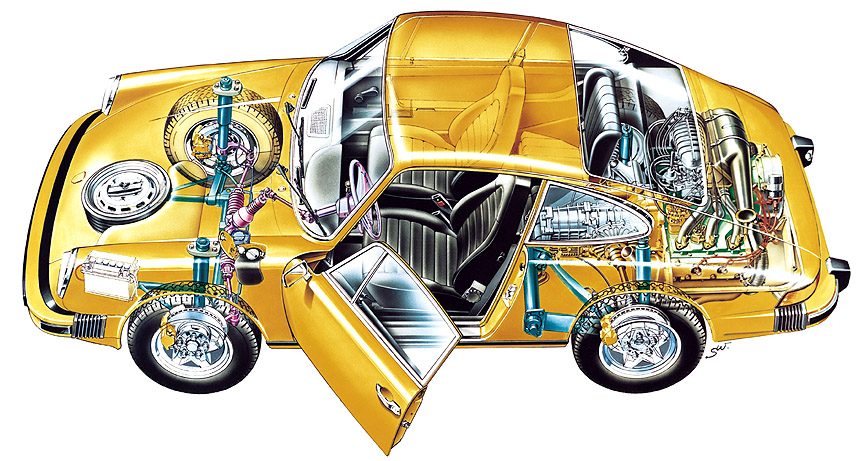
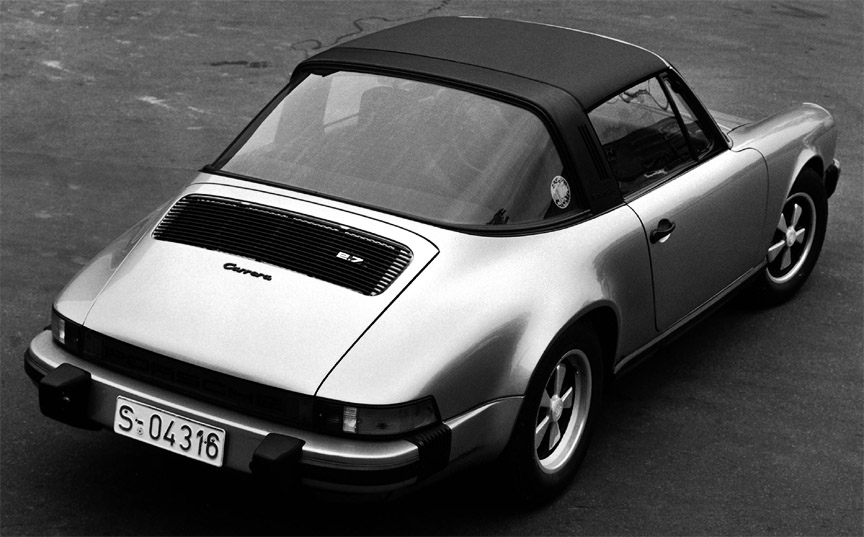
The standard engine was now 2.7-litres in comparison to 2.4 in the earlier model. 2.7 – 3.0-litre engines had been used earlier, but were reserved for motorsport models. The 154 kW Bosch/Kugelfischer-injected Carrera-engine used in MY1973 911 Carrera RS 2.7 was kept in production, but used only on the 911 Carrera models for European markets. The base model had 110 kW for all the markets and the European market “S” or Sports version had 129 kW. The importer for USA, Porsche+Audi division of Volkswagen of America, sold the European “S” in USA as Carrera. What a chutzpah against the US Porsche customers!
The next model year (MY1975), the power of the US-model Carrera was reduced further and now the European “S” was more powerful than the US Carrera. This double-nonsense luckily happened only on MY1975. The 110 kW base version was sold in USA only for the first model year (MY1974) and kept in production for Europe for MY1975 and for Japan for MY1976. In MY1976 the base model in Europe had 121 KW. The same car was sold in Japan as “S” as the 110 kW model was still sold in Japan. The 121 kW version was sold as “S”, too, in USA, although it was the base model on that market.
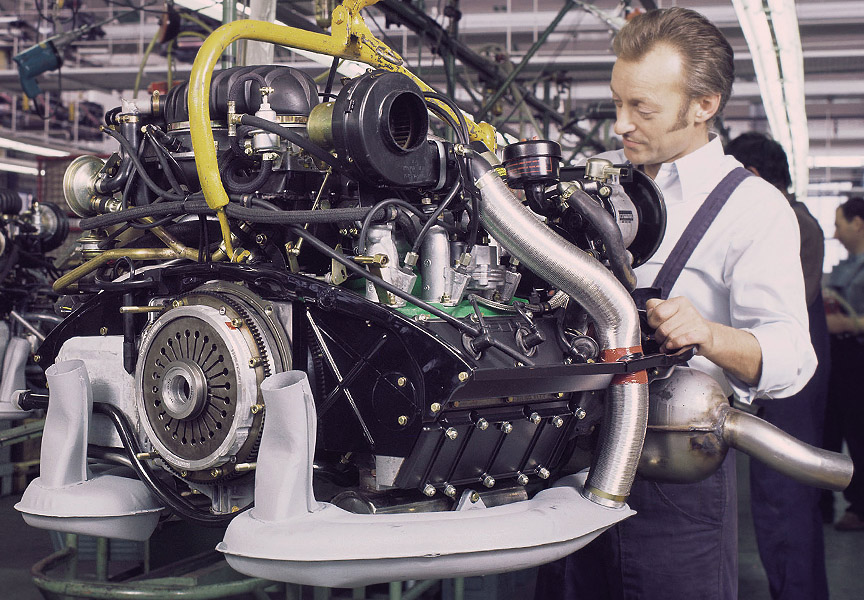

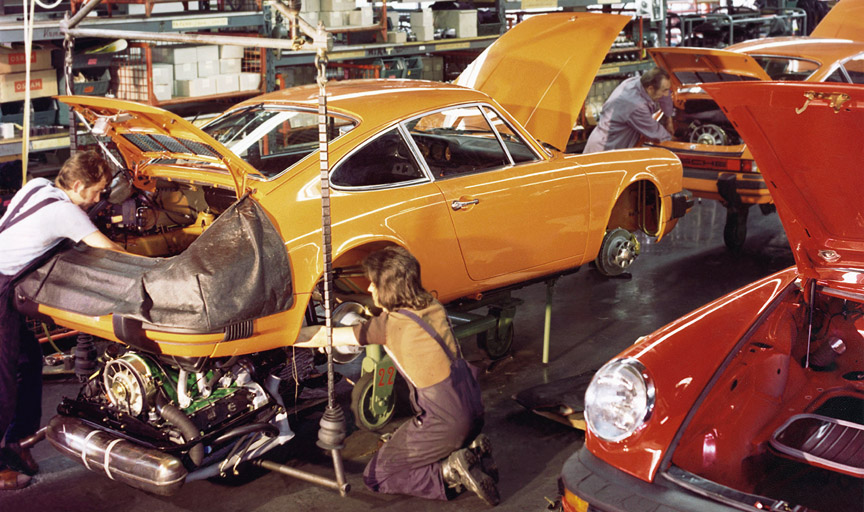
Shown at the 1973 Frankfurt Motor Show was also the prototype of the 911 Turbo. The show car was beautiful, without the impact bumpers. The car shown was much closer to the MY1974 911 Carrera RS 3.0, than the future “Turbo”, but for the exhibition it was labeled “911 Turbo”.
The car had a new rear spoiler, which would soon be called the “whaletail”. The whaletail on the 1973 IAA car was very wide and was only used on the MY1974 911 Carrera RSR 3.0 racing car. The production 911s got a similar rear wing, but not that wide. The narrower whaletail was used on many production 911s starting with the MY1975 911 Turbo until MY1989 911 Carrera 3.2 and in altered design also on 911 964 Turbo S 3.3 and 911 993 Carrera RS.
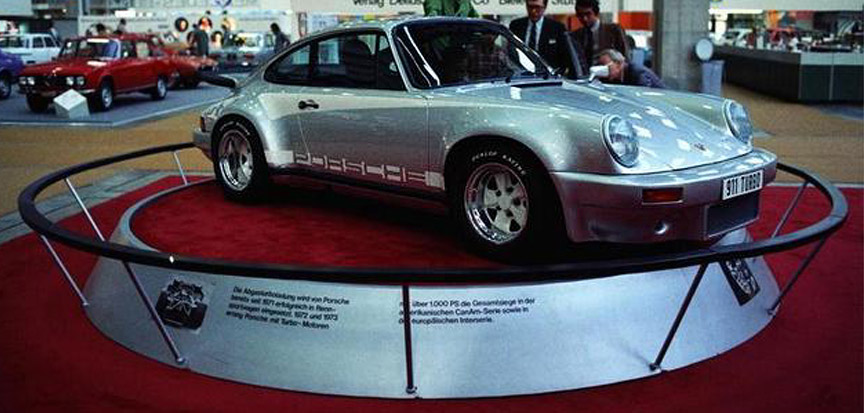



Following the famous 1973 F-model 911 Carrera RS 2.7, Porsche built its successor based on the G-model and it was called the 911 Carrera RS 3.0. This road legal racing car was first shown at the Geneva motor show in March 1974. With its 172 kW engine, it was the most powerful series production street-legal Porsche made so far.

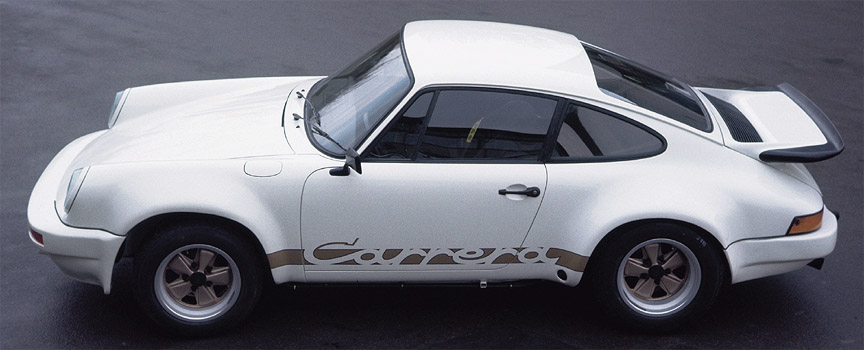

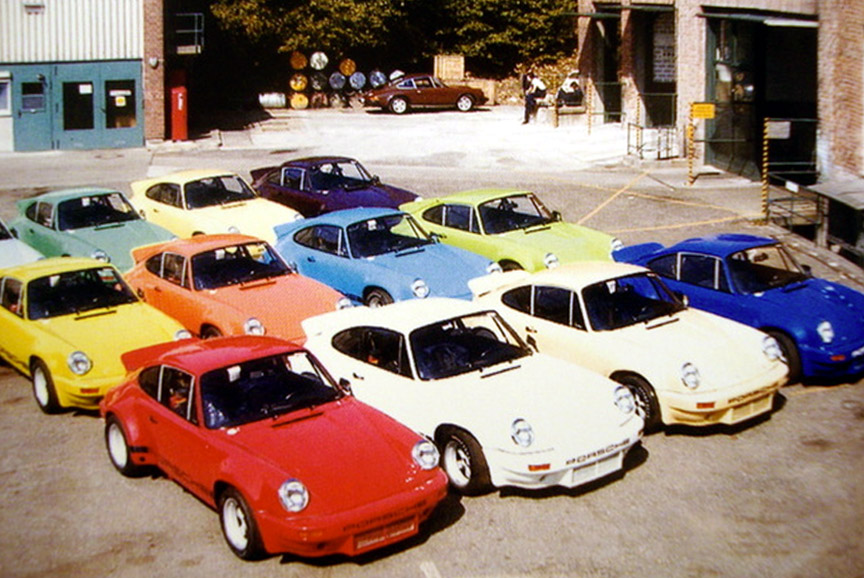

For the 1974 racing season 911 Carrera RSR 3.0 (246 kW) and RSR Turbo 2.1 (338+ kW) were created – the 3.0L for the customer teams and the 2.1 turbo for Porsche’s own team. The reason to produce 911-based cars for racing was marketing. But, any 911-based car would be heavier than racing prototypes of other teams, so Porsche needed more power. Porsche’s engineers knew that turbocharging might help.
The coefficient for the turbocharged cars was 1.4, so in order to fit into the 3-litre class, the engine displacement was limited to 2.1-litres. The 911 Carrera RSR Turbo 2.1 developed 460-500 PS (338-368 kW) peak power, but as the engine was small, the turbo lag was big and it wasn’t as easy to drive out of the corners as it was with the 3-litre normally aspirated car.
Weight reduction measures included plastic hoods, fender flares and doors (each weighing 2.25 kg/5 lb) and the safety cage was made of (not so safe) aluminium. The fuel tank was located in the co-driver’s position.
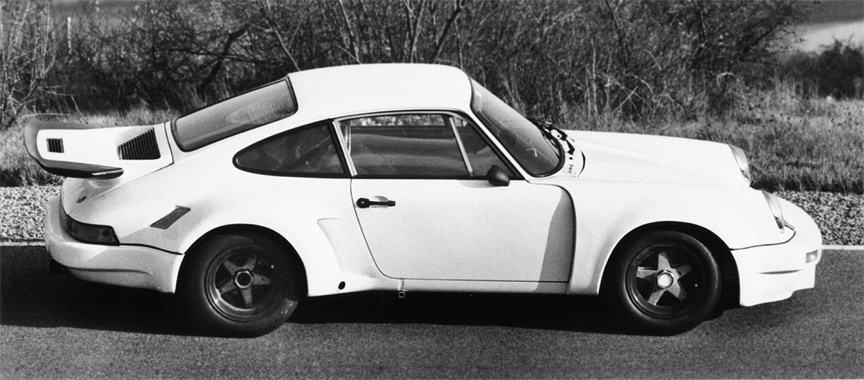


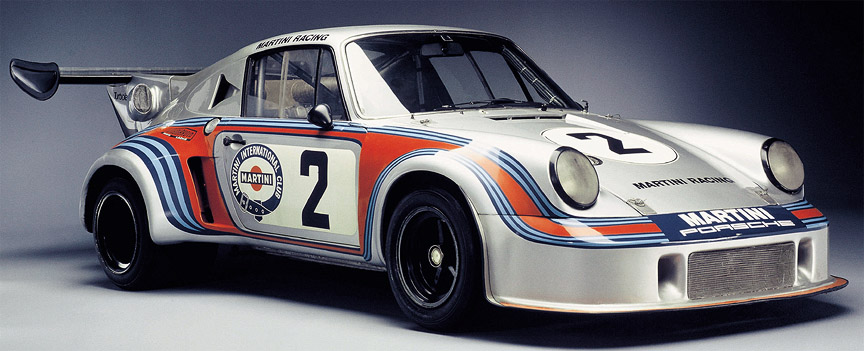





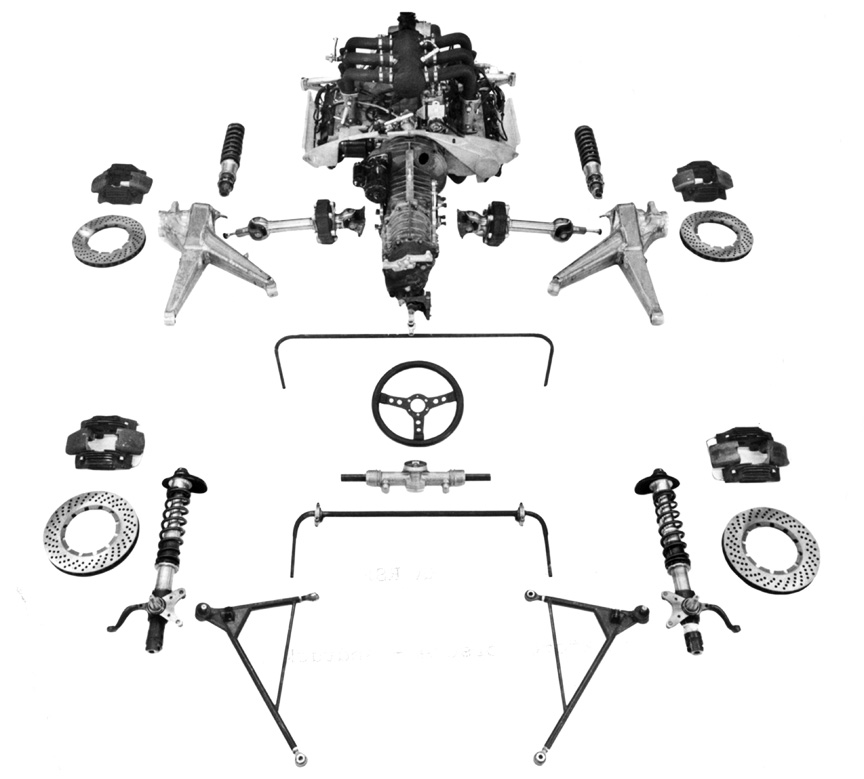
In 1974 Le Mans 24H, Martini Racing Team (Gijs van Lennep/Herbert Müller) 911 Carrera RSR Turbo #22 and Matra prototype #7 battled for the victory. The Matra used a Porsche-developed gearbox which failed on the second day and the #22 Porsche could have won the race, but Porsche sent its mechanics into Matra’s garage to fix the leader’s gearbox in record time.
Ironically the gearbox of the Porsche #22 also failed leaving them only with the fourth gear. The Matra won and the 911 became second – still a remarkable result for a production based car against the racing prototypes. The normally aspirated 911 Carrera RSR 3.0 cars were successfully entered by customer teams.
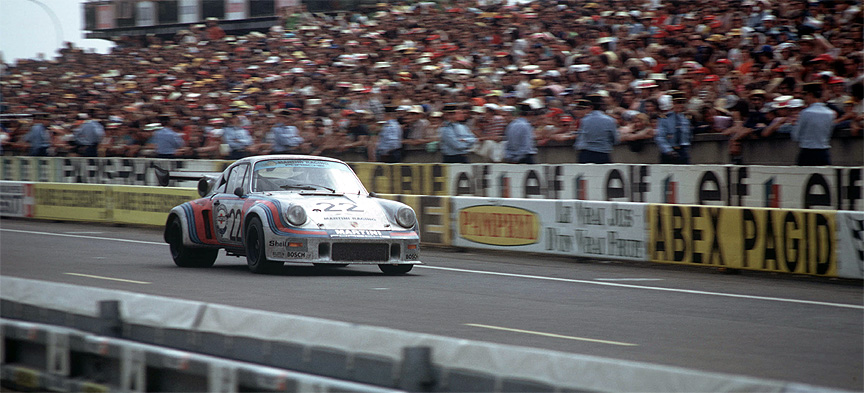
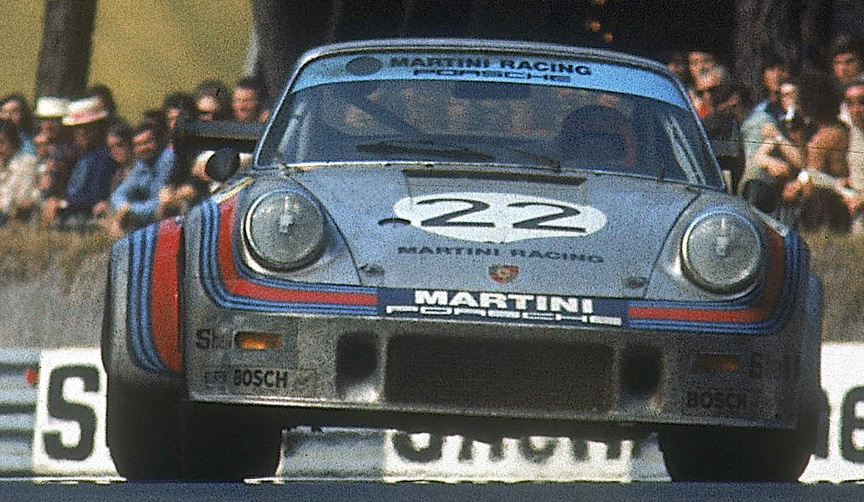


Before the actual introduction of the 911 Turbo production version, Porsche engineers built one narrow-body version for Louise Piėch, Ferry Porsche’s sister, who was an important person in building up the company and Porsche sales, and was also the mother of Ferdinand Piėch.
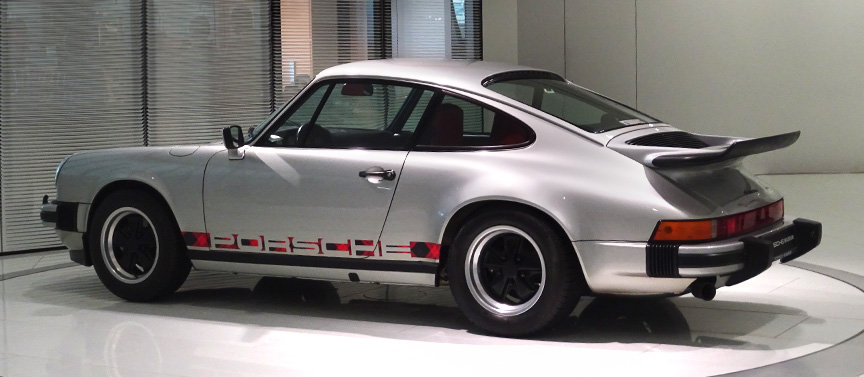

While the 911 Turbo prototype was introduced at the 1973 Frankfurt Motor Show, the quite different production version was introduced at the 1974 Paris Motor Show (Salon de l’automobile et Motocycle, October 3-13). The first version was lacking the intercooler. The European version 911 Turbo 3.0 developed 191 kW at 0.8 bar/12 psi boost and had a top speed of 260 kmh/162 mph. The 911 Turbo was also called Porsche 930.
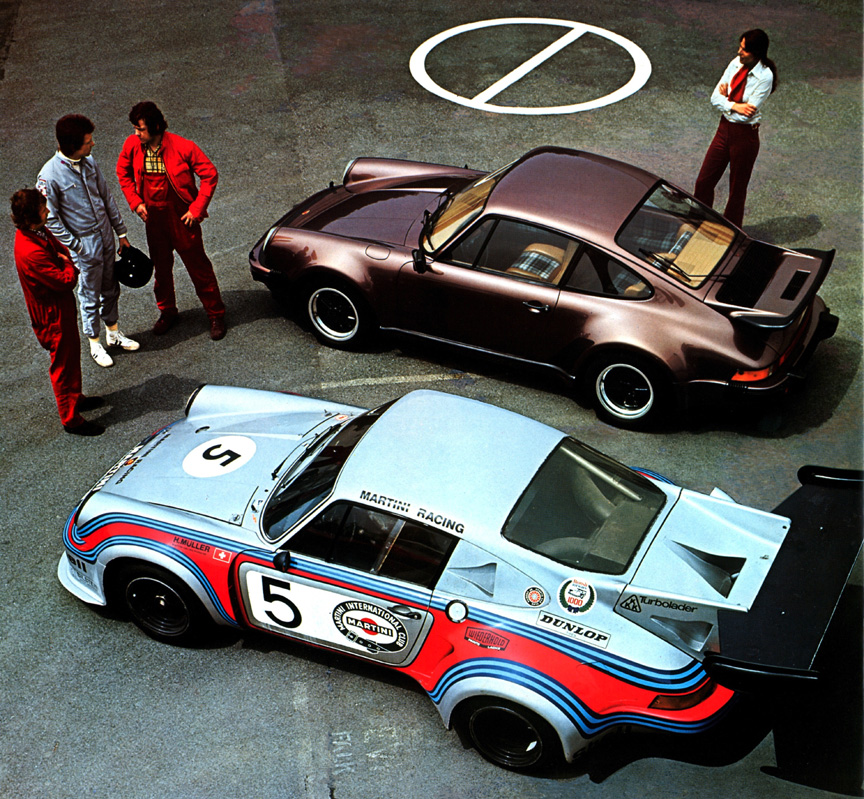
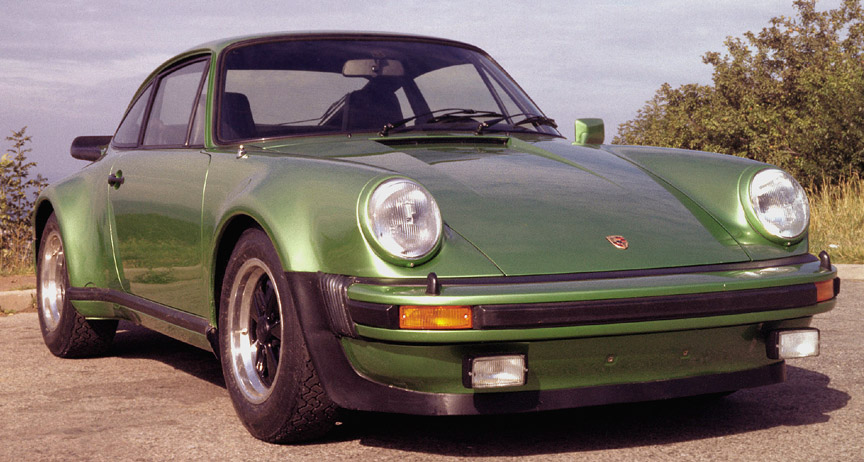

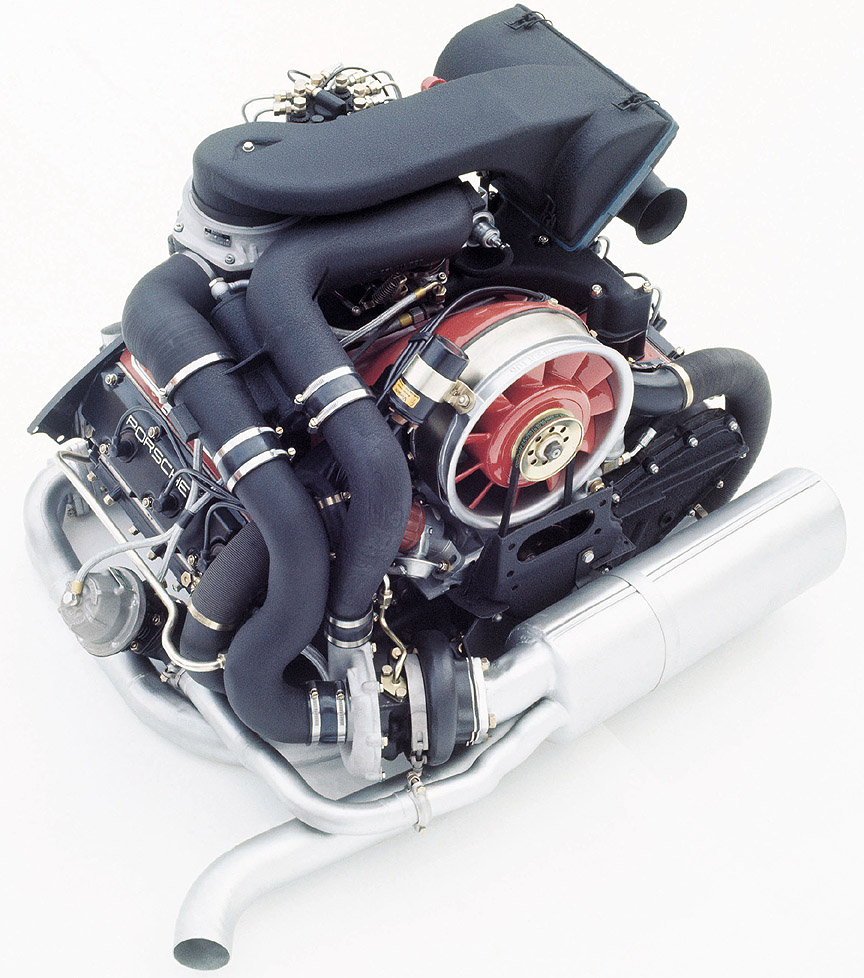
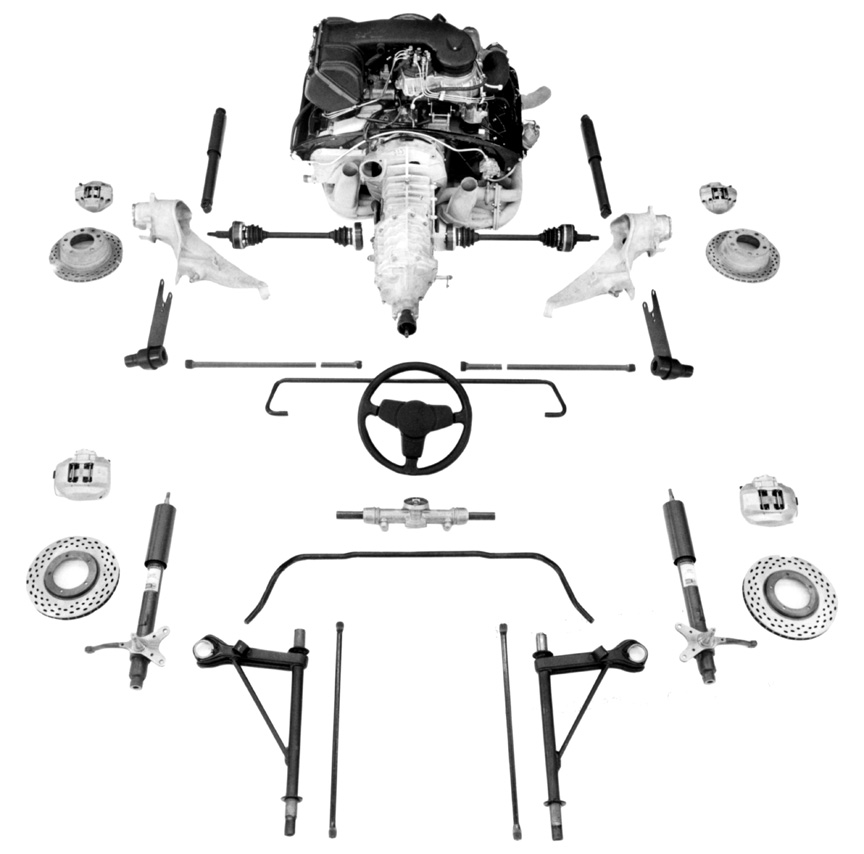
The MY1975 European pricelist showed that compared to the 110 kW base model 911, the 129 kW 911 S was 12% more expensive and the 154 kW Carrera was 37% more expensive. 911 Targa was 7% more expensive than the 911 Coupé. The 911 G-model Carrera 2.7 was also available with the Targa body. In MY1975 the entry level model was the 914 which had the targa top as standard. For the money of the 911 Targa you could easily get two 914s. Of course there was a reason for that – the most powerful 914 that year had only 74 kW of power.




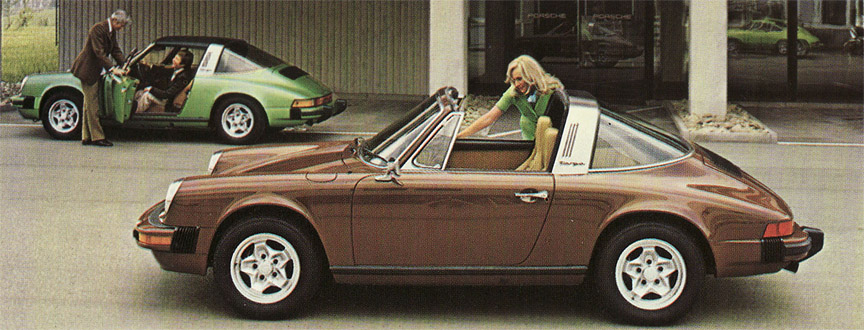

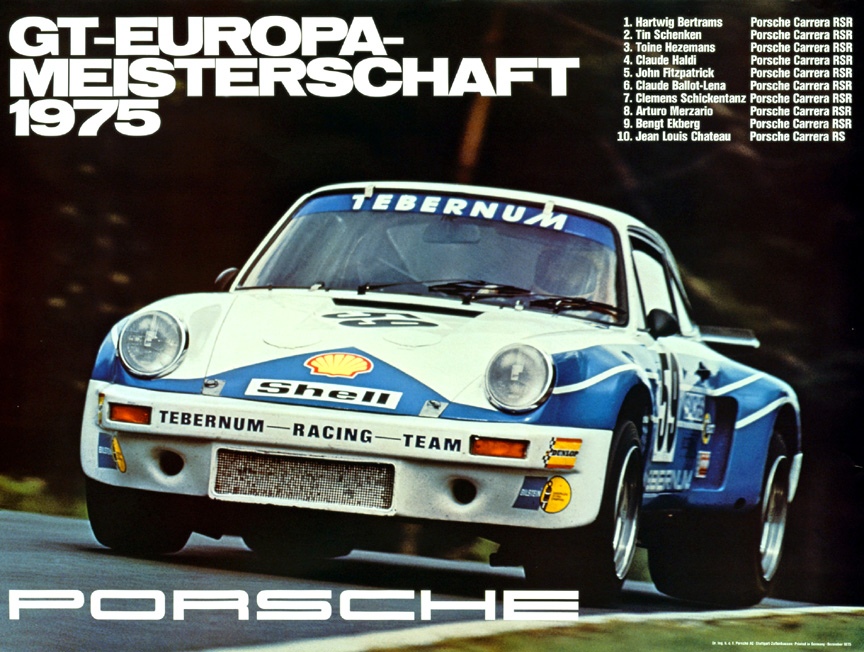
Starting with MY1976 the cars received full body galvanization. That was a major step in extending the pleasure of ownership of these cars. It is estimated the zinc layer added 10 kg/20 lb of weight to the body.

For MY1976 electrically adjustable and heatable mirrors were introduced, nicknamed as “elephant ear”-mirrors. Due to their size and shape they provided very good rear-view vision and were used on all Porsches until MY1991 (except 964 Turbo which got the aero-mirrors from MY1991 when it was introduced).
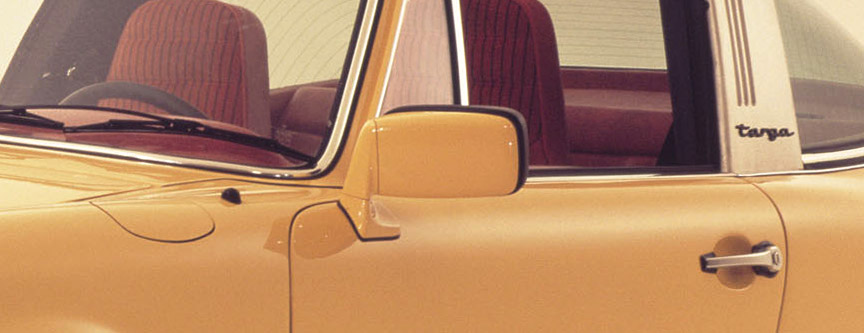
For US market 912E was introduced for MY1976 as an entry-level Porsche as the 924 wasn’t yet available for America. The 912E (E for Einspritzung, “injection”) had 4-cylinder VW engine from Porsche 914/4 2.0. It had electronic L-jetronic fuel injection system, which would become available for 911 only after 8 years, in the 911 Carrera 3.2. The 912E was a cheap show-off car – it was 911 from the outside, but the engine power was half of the base 911. The 912E was produced for one model year only.
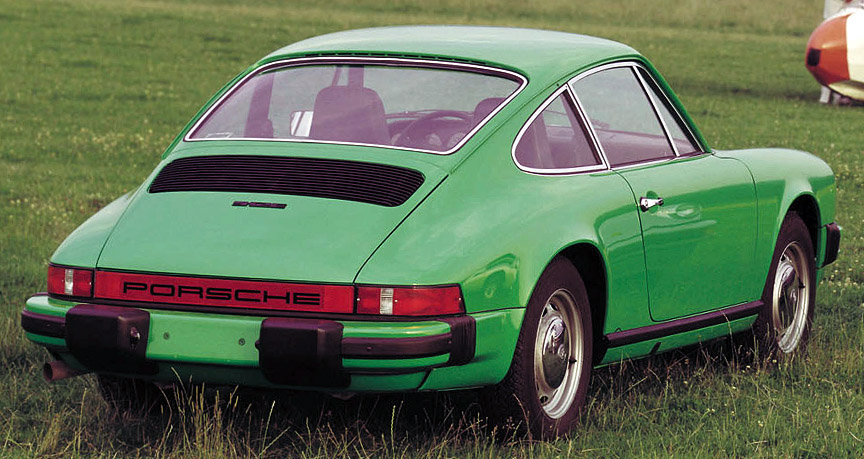
For model year 1976, 911 Turbo was introduced on other markets, but engine power was reduced compared to the cars sold in Europe.

For MY1976 and 1977 the 911 Carrera 3.0 was produced. It had 147 kW, which was 7 kW less compared to the 911 Carrera 2.7. Around 3700 Carrera 3.0 were made incl. ca 30% Targas. Most cars were ordered with the proven 5-speed manual gearbox, but 1-2% were ordered with the lousy 3-speed sportomatic gearbox (yes, the sporto had lost another gear for MY1976).
In 1977, for MY1978, engines in base 911 and in 911 Turbo both got displacement increase of 0.3 litres. The base model was now 911 SC with 3-litre engine and 132 kW power output, while the Turbo got 3.3-litre engine with intercooler and developed 221 kW in European version (195 kW in US-version).
As the 911 Turbo now had an intercooler, a smaller turbocharger could be fitted and therefore the turbo lag was reduced. Because the intercooler couldn’t be fitted under the engine lid, a new rear spoiler was created that could house the charge air cooler. The new rear spoiler had upwards bent edges and was therefore called the “tea tray”. In addition to the power increase, new brakes from the Porsche’s racing department were installed.
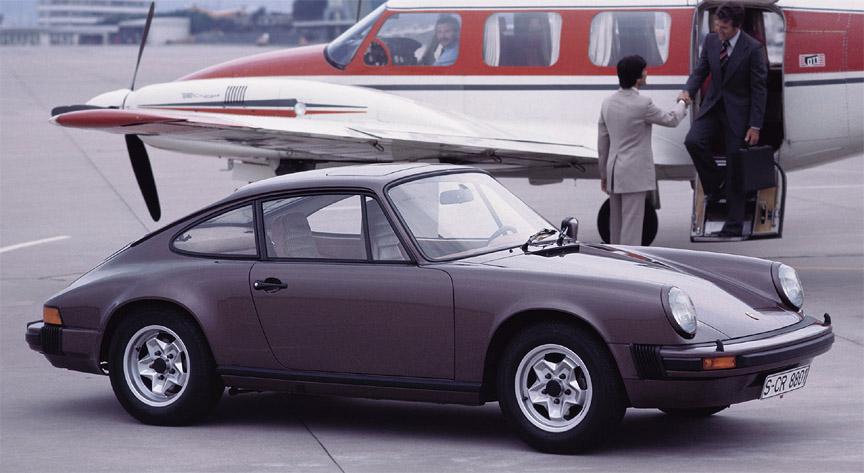
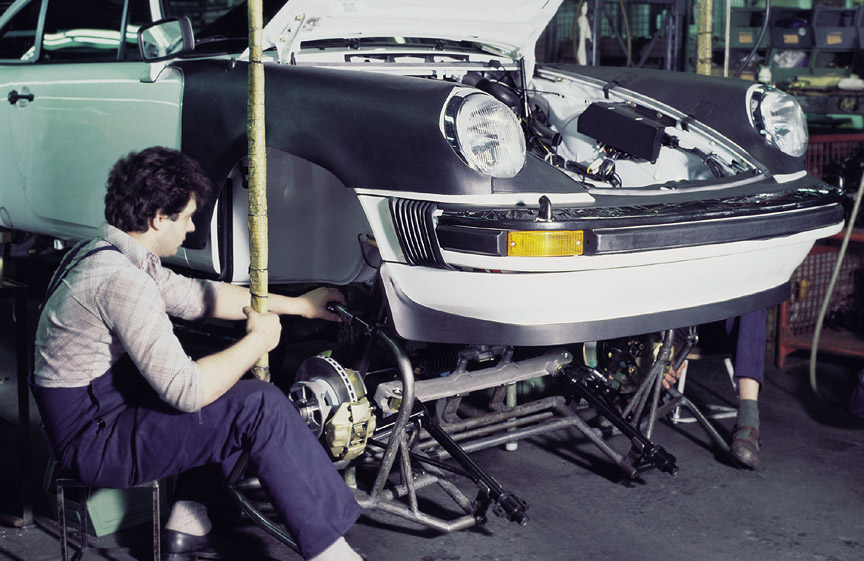
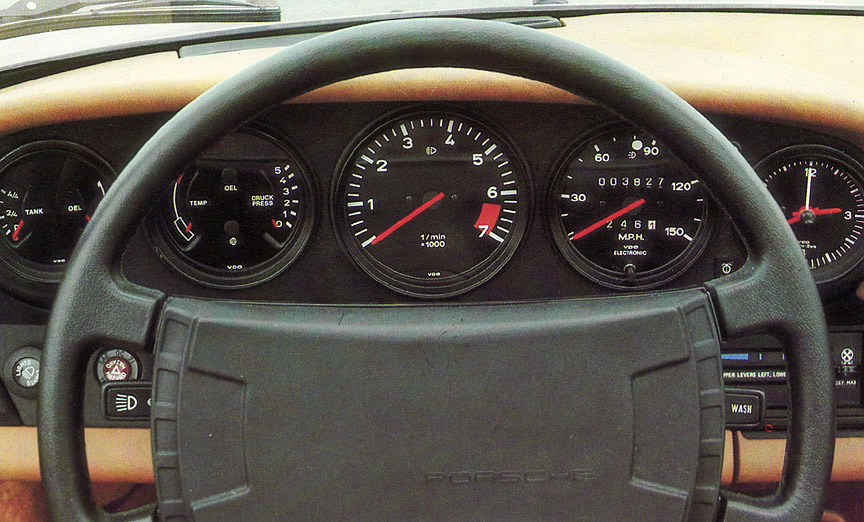




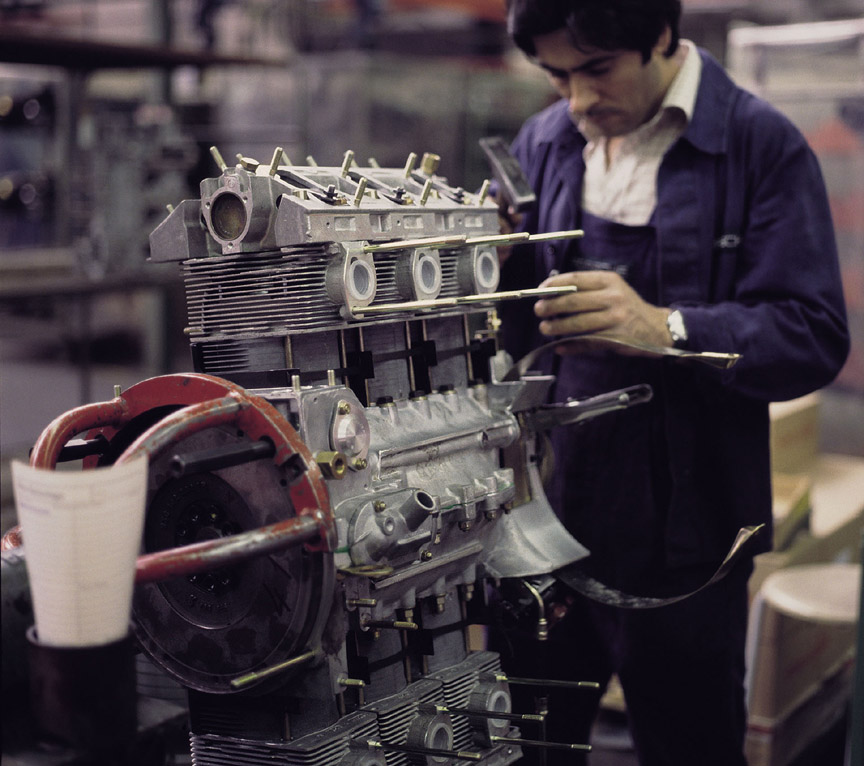
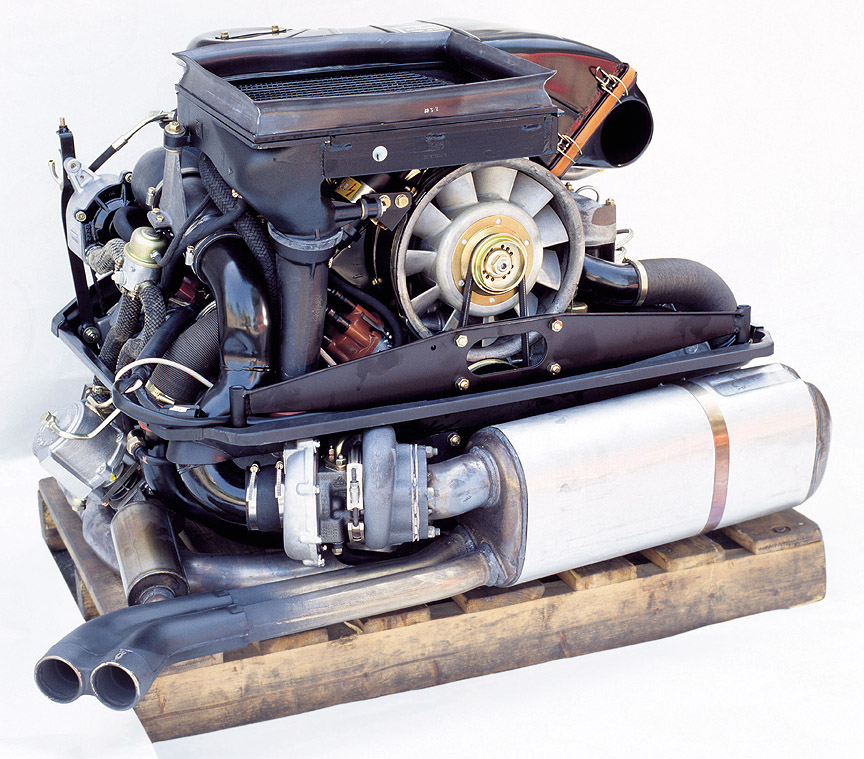
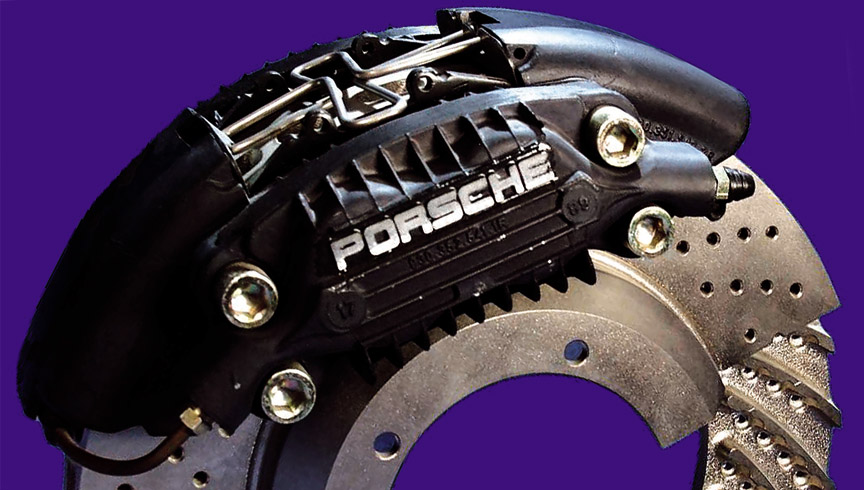

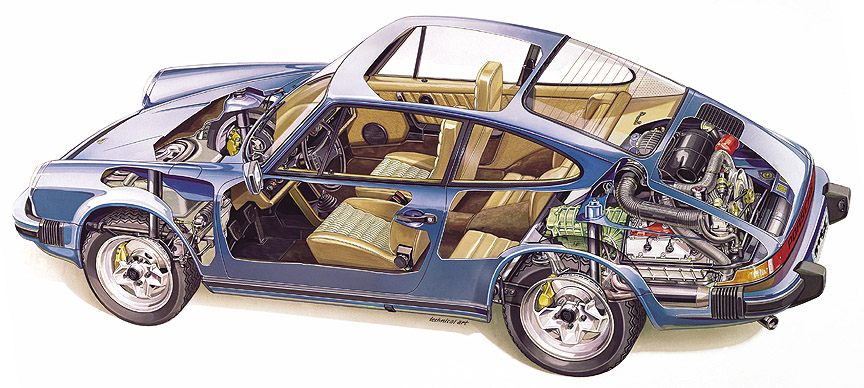
The “SC” most likely standed for Sport Comfort. The 911 SC came to market at the same time with the new high-tech 928 and there was the believing that the 928 would render the 911 obsolete and the SC was considered as farewell to the 911.
It is interesting to know that what became the 928, was on the drawing board in 1971 as the 911 with rear-mounted V8 (its exterior design was from the beginning what we now know as 928, but its V8 landed at the front later and then it was renamed from 911 to 928). When afficionados asked Porsche’s CEO Ernst Fuhrmann, why he wants to stop making the 911, he answered “We will build this car as long as people want to buy it…
Only when production volume falls below 25 per day will we have to end it.”
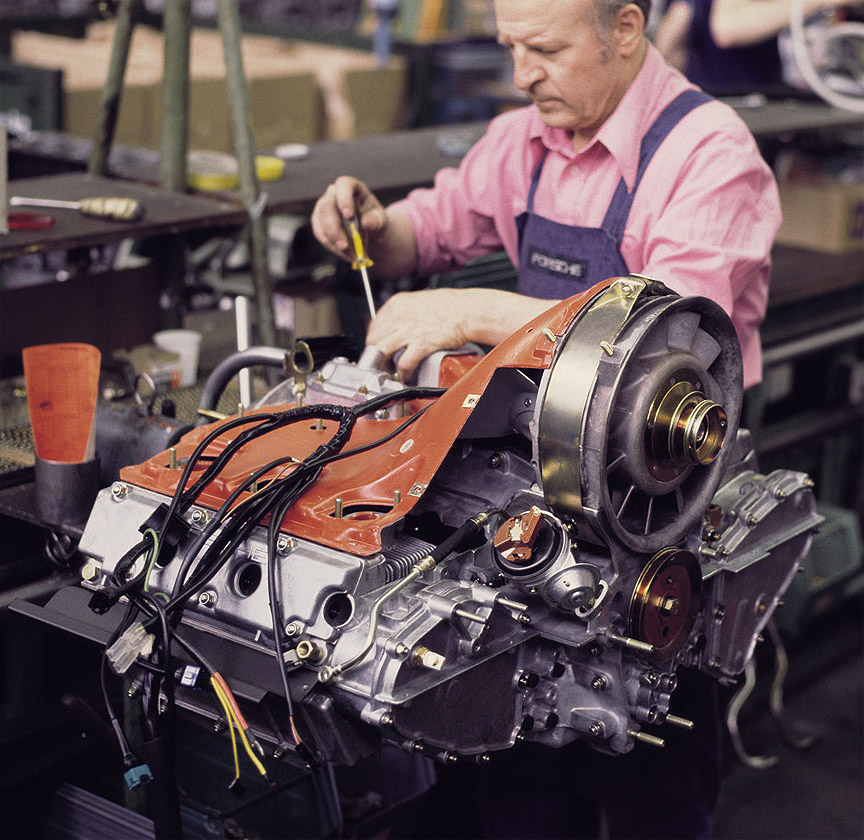
For the 1978 Safari Rally held in Kenya between March 23 and 27, Porsche created 911 SC Safari-versions. As the ground clearance was seriously improved, the drive shafts had to work in abnormal angles and were destroyed on both cars during the rally. Despite these and other technical problems common in desert rallies, Porsche managed to score 2nd (#14 Vic Preston jr./John Lyall) and 4th (#5 Björn Waldegård/Hans Thorszelius).
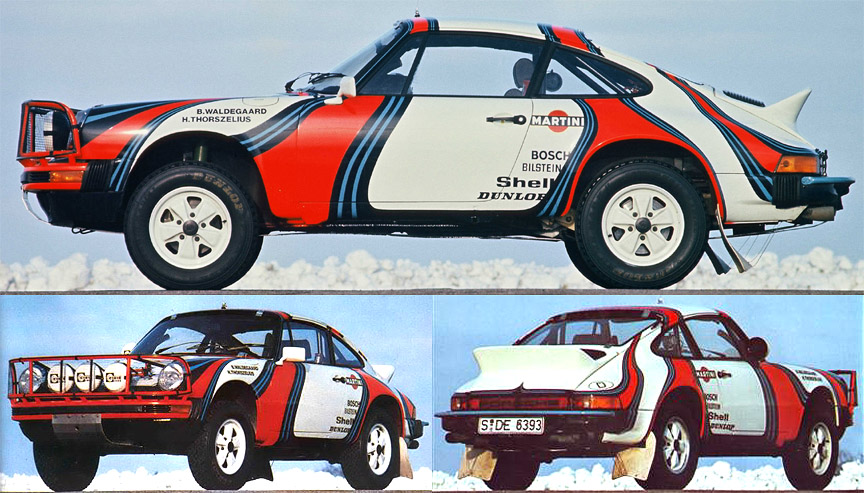
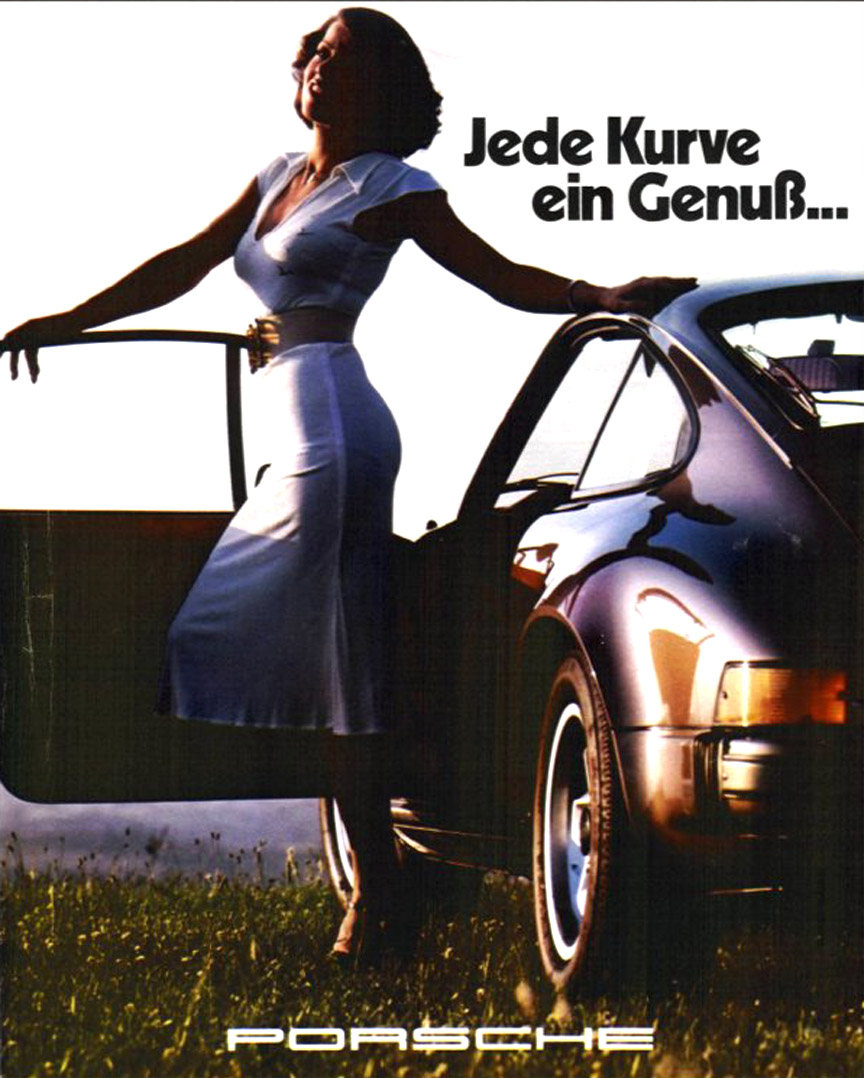
For MY1980 Porsche importer for North America, the Porsche+Audi division of Volkswagen of America, stopped selling 911 Turbos in USA, but ordered a bunch of 911 SC’s with whaletail and golden Fuchs wheels and sold them as 911 SC Weissach Coupés.
While the marketing guys in the USA added whaletails to boost 911 SC sales, guys in Germany added power to the European version. The European SC got a 6 kW boost for MY1980 (now 138 kW) and another 12 kW boost for MY1981 (now 150 kW). And when the 3-litre wasn’t enough a factory power increase could be ordered in a form of a 3.1-litre 154 kW engine.
In 1980 (as MY1981) the first Flachbau model was created in Porsche’s Werk I. German “Flach” means “flat” and the Flachbau models have been therefore called as “slantnose” or “slopenose” editions. For the first years, these cars remained one-off special order cars. Initially they had lamps only in front spoiler.
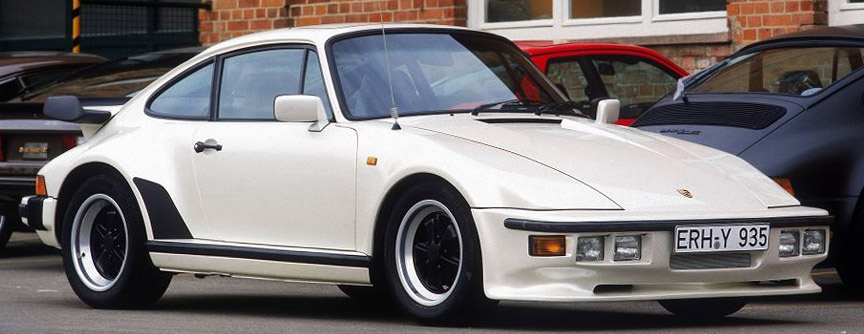
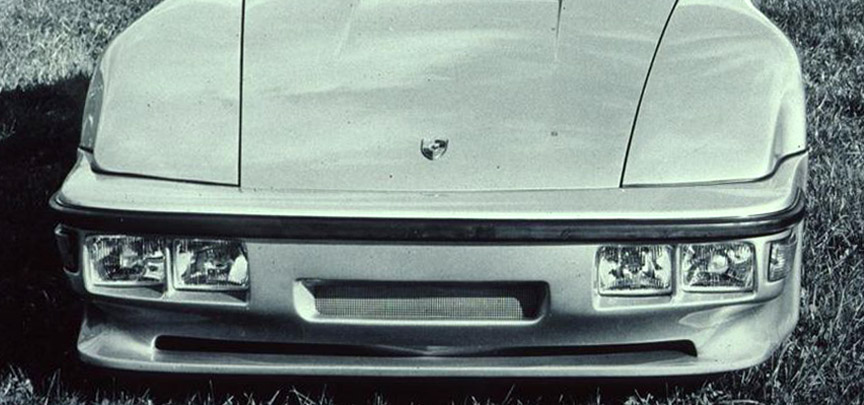
From MY1981 all Porsches got the VIN numbers instead of chassis numbers. USA made the 17-digit Vehicle Identification Numbers mandatory for all manufacturers who wanted to sell their cars in USA. VIN was a great initiative – every VIN is unique in the world and carries the information of the manufacturer, the model, model year and production plant.
At the 1981 IAA Frankfurt Motor Show Porsche showed a 911 Turbo Cabriolet prototype. Supposedly the car even had a 4WD system. At least the conversion to the body to install 4WD parts was done. If it ever had propulsion power connected to its front wheels is not known to us.
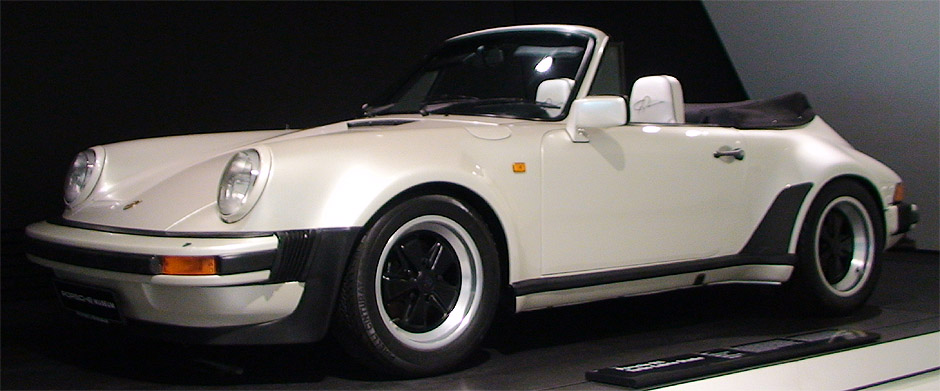



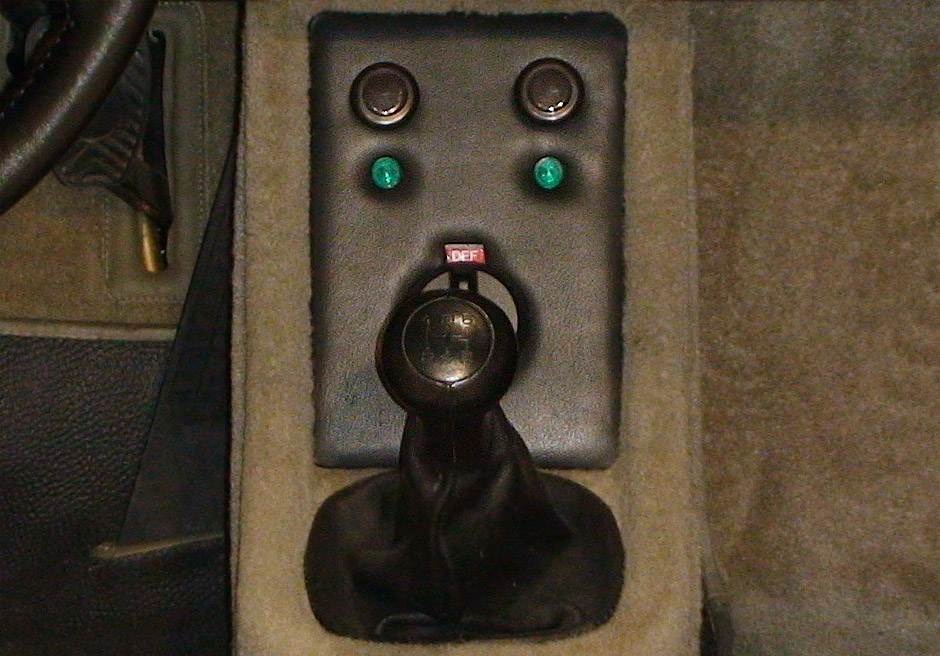

In 1981 (as MY1982 car) Porsche released a cosmetic limited edition 911 SC with Ferry Porsche’s signatures stitched on the headrests. The 911 SC Ferry Porsche Edition was produced both in Coupé and Targa form. There wasn’t anything so special about the configuration of the car, but Ferry Porsche as a person is so special that this edition is just special. A powerkit for the turbo engine was now available producing 243 kW.
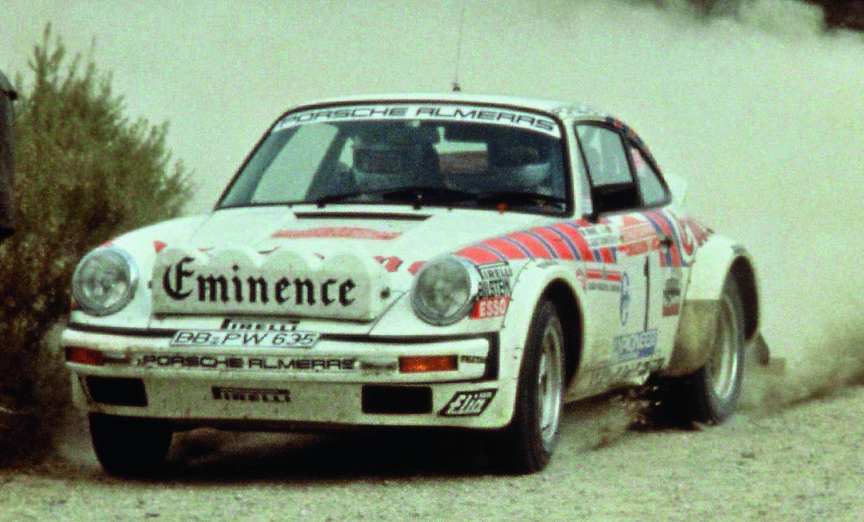
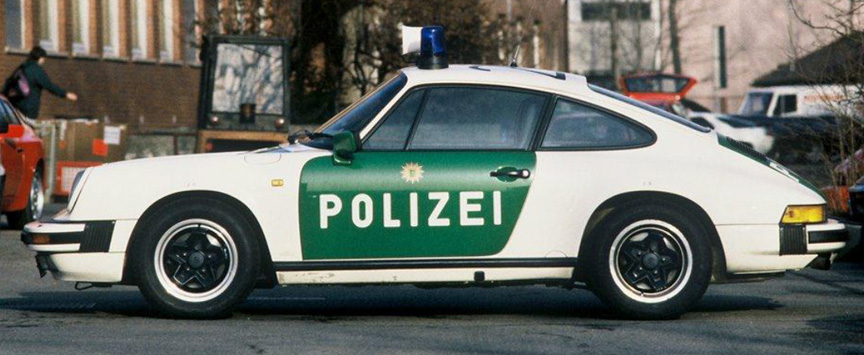
Available from September 1982 for the last, 1983, model year of 911 SC series production cars, the first series production 911 Cabriolet was introduced. Since the end of the production of the 356 in 1965 there were no cabrio in Porsche’s portfolio. Targas had served the open car enthusiasts in the meantime.

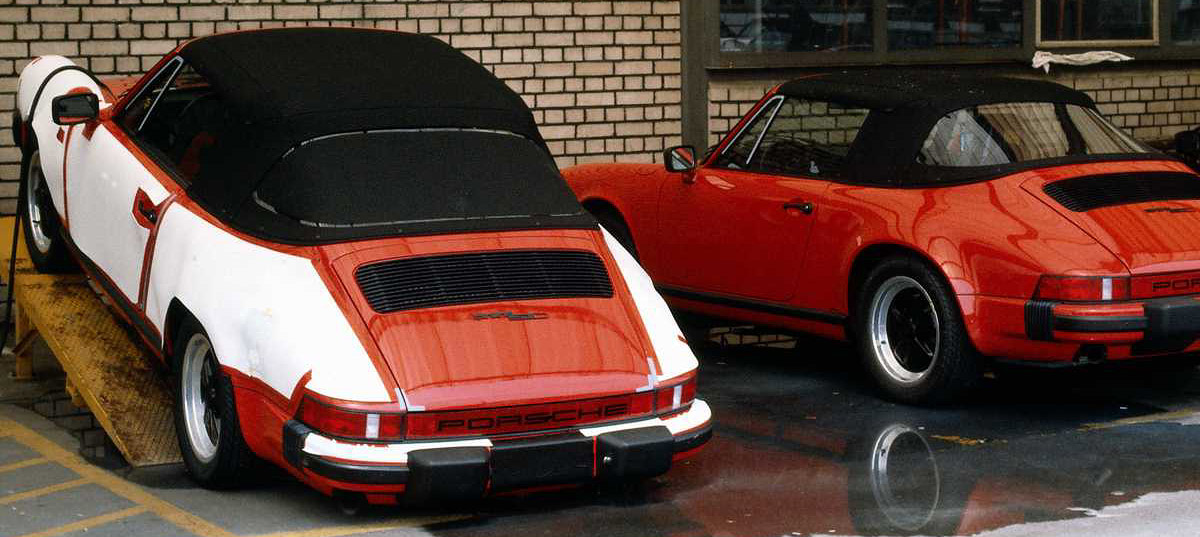
The Flachbau got 924-style pop-up headlights and new front spoiler for MY1983. The US-versions didn’t get the new front spoiler and were delivered with the standard 911 Turbo front lower valance.
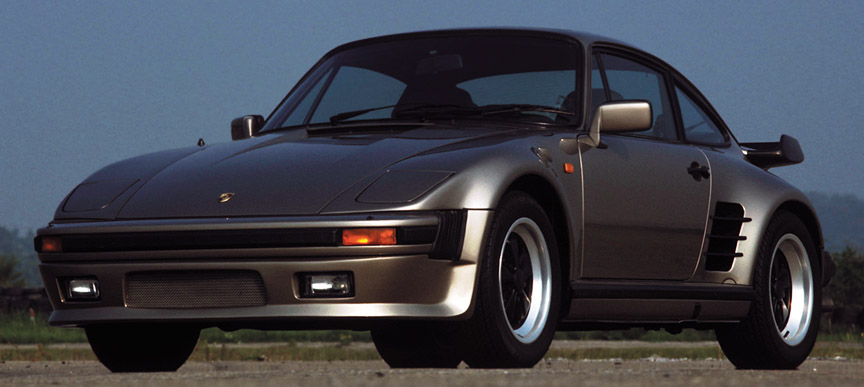

Starting from May 16, 1983, the printed labels with VIN, M-codes etc. were installed under the front lid.
For the 1984 model year, the 911 SC 3.0 was replaced by the 911 Carrera 3.2. Visually everything remained the same except the “911SC” badge at the engine lid was replaced by “Carrera”. From now on, the “Carrera” stood for base model and not for the top of the line model. The 3.2-litre developed 170 kW without the catalyst and 152 kW with the catalyst. As an innovation, the connecting rods were made of titanium as on the 959 prototype, also shown in 1983.

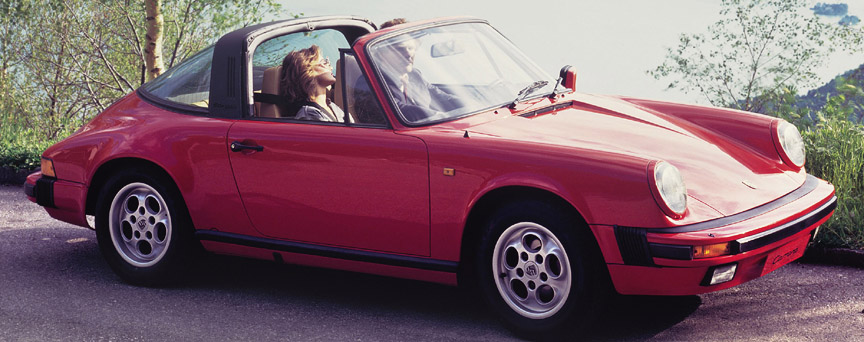

Porsche took part and won the 1984 Paris-Dakar Rallye held from January 1st to 20th with the specially developed 4-wheel-drive 911 Carrera 3.2. There had been a few 4WD cars in the history of Porsche already since 1900, but 4-wheel-drive concept wasn’t seriously used before the 911 Carrera 3.2 4×4 aka Porsche 953.
Three 953s took part and all finished the cruel 11.000 km rallye. Some sources say, not all of them were 3.2-litre cars. The 3.2-litre unit in the winning car had 5 kW less than the production version because the compression ratio was lowered due to lower quality gasoline available in Africa. The car carried an astonishing 270 litres of fuel on board (120 litre tank in front luggage compartment and 150 litre tank behind the seats). The list of Porsche teams looked like this:
- #175 Jacky Ickx / Claude Brasseur (finished 6th)
- #176 René Metge / Dominique Lemoyne (winners)
- #177 Rene Kussmaul / Erich Lerner (finished 26th)
In addition to the overall victory, Porsche won also in the teams category.
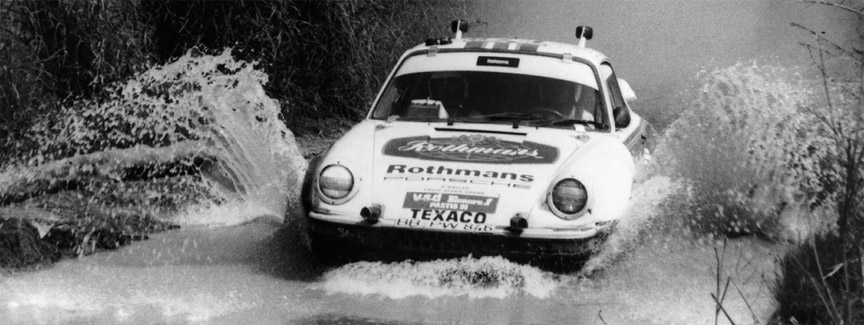
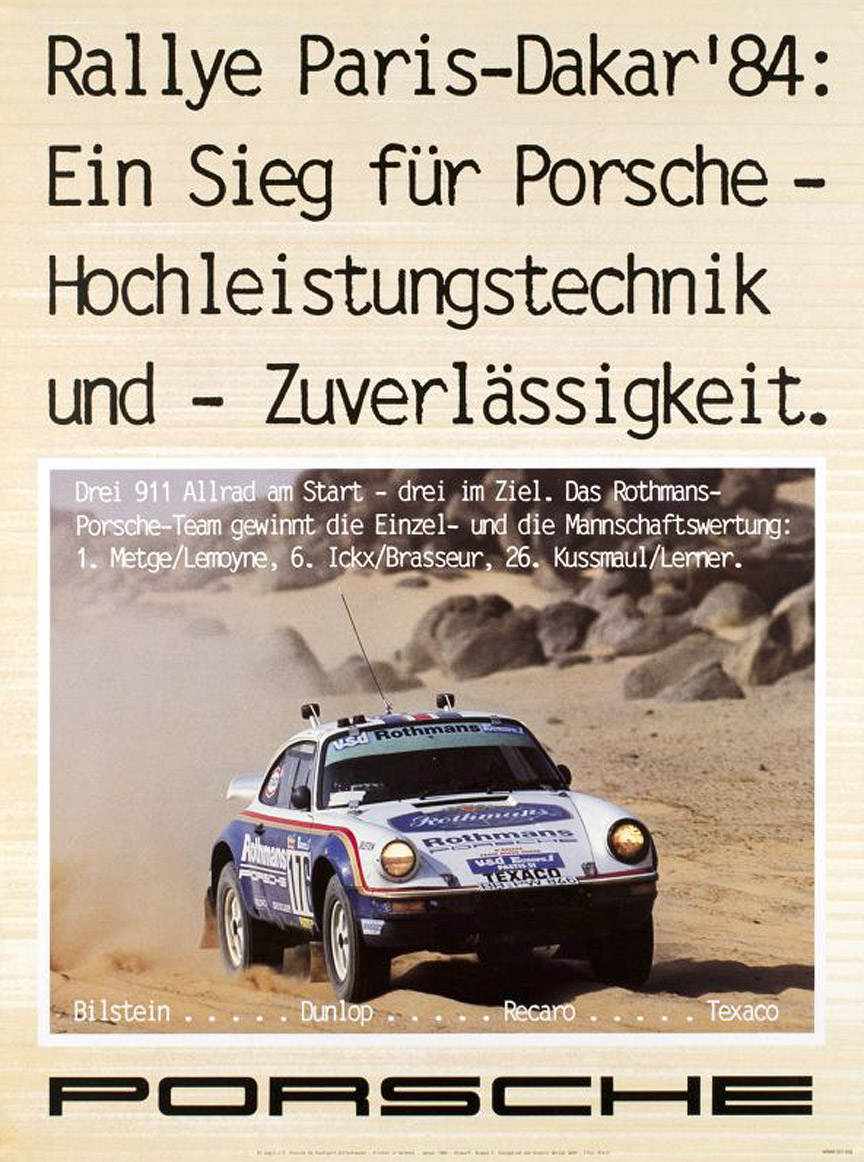
Although the 911 SC was discountinued for MY1984, Porsche produced 20 911 SC RS competition cars. The special 3-litre engine developed 188 kW. With the help of aluminium and plastics the curb weight was dramatically reduced, to 960 kg/2116 lb. Saeed Al-Hajri took victory with the 911 SC RS in the first competition the car entered, the 1984 Qatar rallye.


From the beginning of the 911 Carrera 3.2 production, Porsche started offering 911 Turbo’s wide body for normally aspirated cars – the posing era had started.




When the Carrera 3.2 was introduced, the engineers focused on the next generation of the 911, the 964. Not yet an 964, but an aerodynamic test car was made based on the 1984 911 3.2. While the standard G-model had a drag coefficient cd (cw) of 0.40, the aerodynamic 911 achieved a figure as low as 0.27 in 1986.

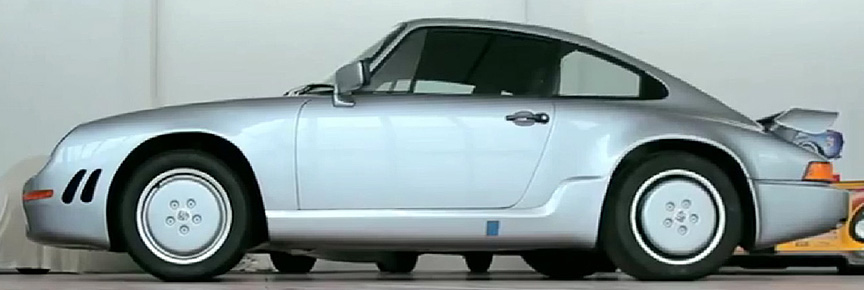

On MY1986, the Targa and Cabriolet versions were added to the 911 Turbo’s line-up and Turbo was back in USA after 6 years gap. The US-version 911 Turbo now had 15 kW more than in the last MY1979 US cars, but still 11 kW short of the European version.

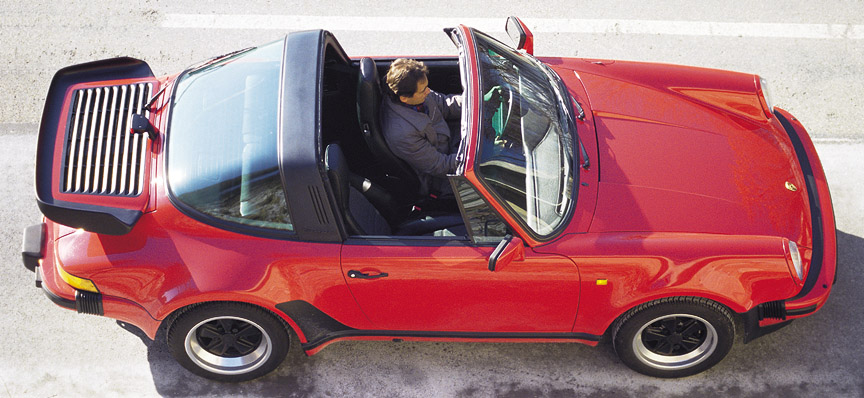
For MY1987 the export models received a power increase of 8 kW (now 160 kW), but these catalyst-equipped cars were still 10 kW short of the European standard 170 kW model. From now on, the catalyst model was also available in Europe in addition to the non-catalyst model. For the MY1987 Carrera 3.2 also the stronger G50 gearbox was introduced.


In MY1987 the 911 Carrera 3.2 became available in slightly stripped form and was called the Club Sport.

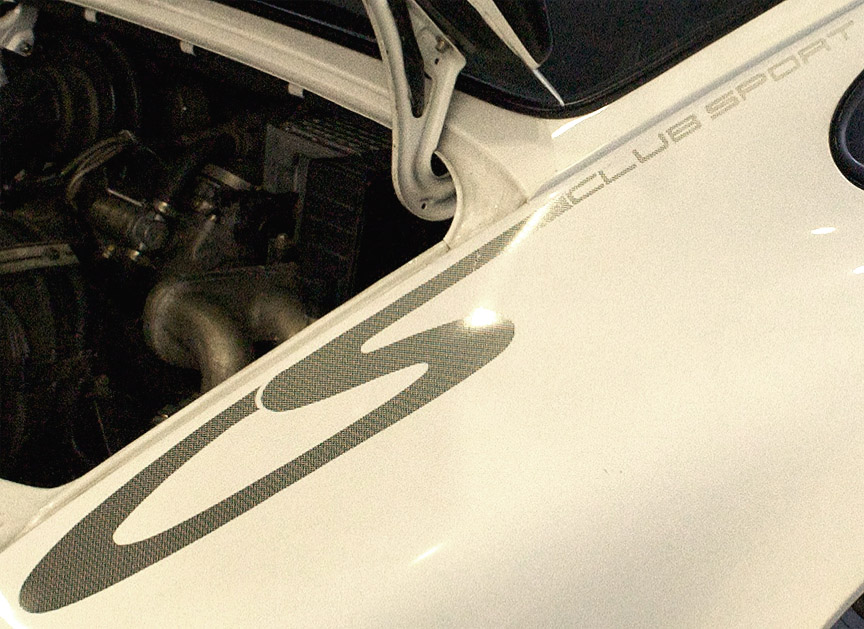
From MY1987 the Flachbau was available also in Targa and Cabriolet form. The Flachbaus weren’t one-offs ordered from Porsche’s Sonderwunsch department anymore and could be specified like other optional extras, with option code M505 for USA (cars with standard 911 Turbo under valance) or M506 for Germany (cars with Porsche Exclusive front spoiler, option code XA4).


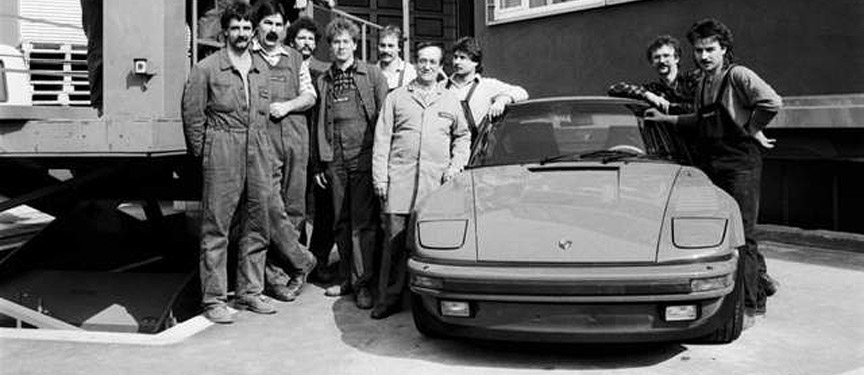

In total 984 Flachbau G-models were made.


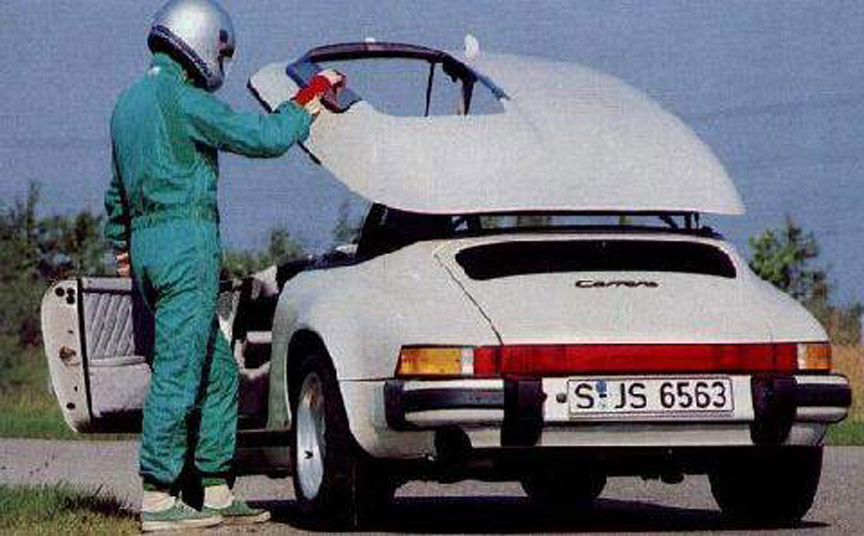
For the last model year, 1989, 911 Speedster was introduced. Over 2000 of these beautiful cars were made. Only ~8% were standard cars with narrow body and ~92% were ordered with Turbo-look widebody out of which a very few cars were given the Flachbau treatment. For the last model year also the “25 years 911” anniversary model was produced based on the 911 Carrera 3.2 Coupé and a 5-speed G50 gearbox was finally installed in the 911 Turbo. The normally aspirated models had always the 5-speed available, but Turbo was for some reason made with 4-speed gearbox until MY1988.

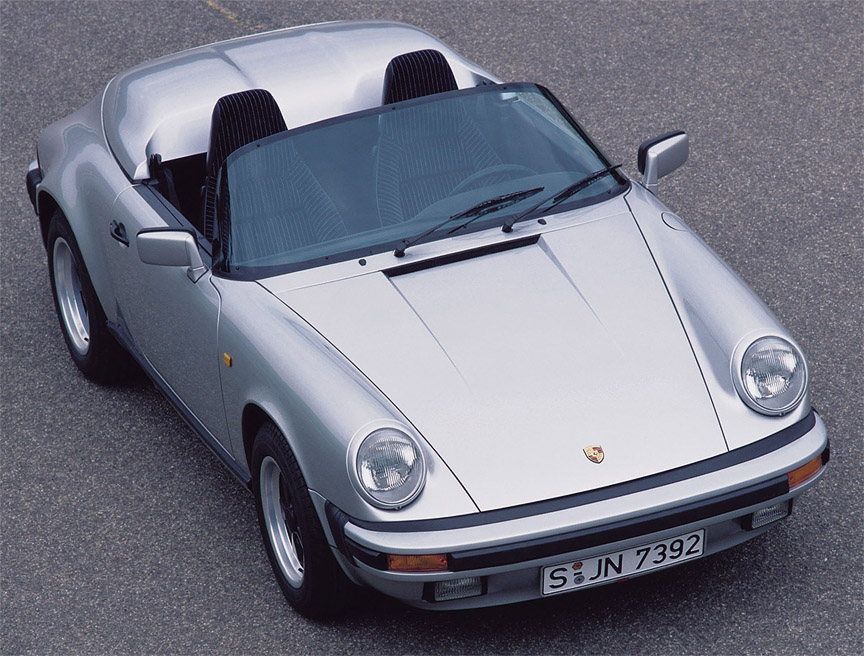


For the MY1989, a new 911, the 964 was introduced. During that model year, both the G-model and the 964 were made.


